[Freezing Preservation Tips Series] How to freeze radish deliciously and reference recipes!
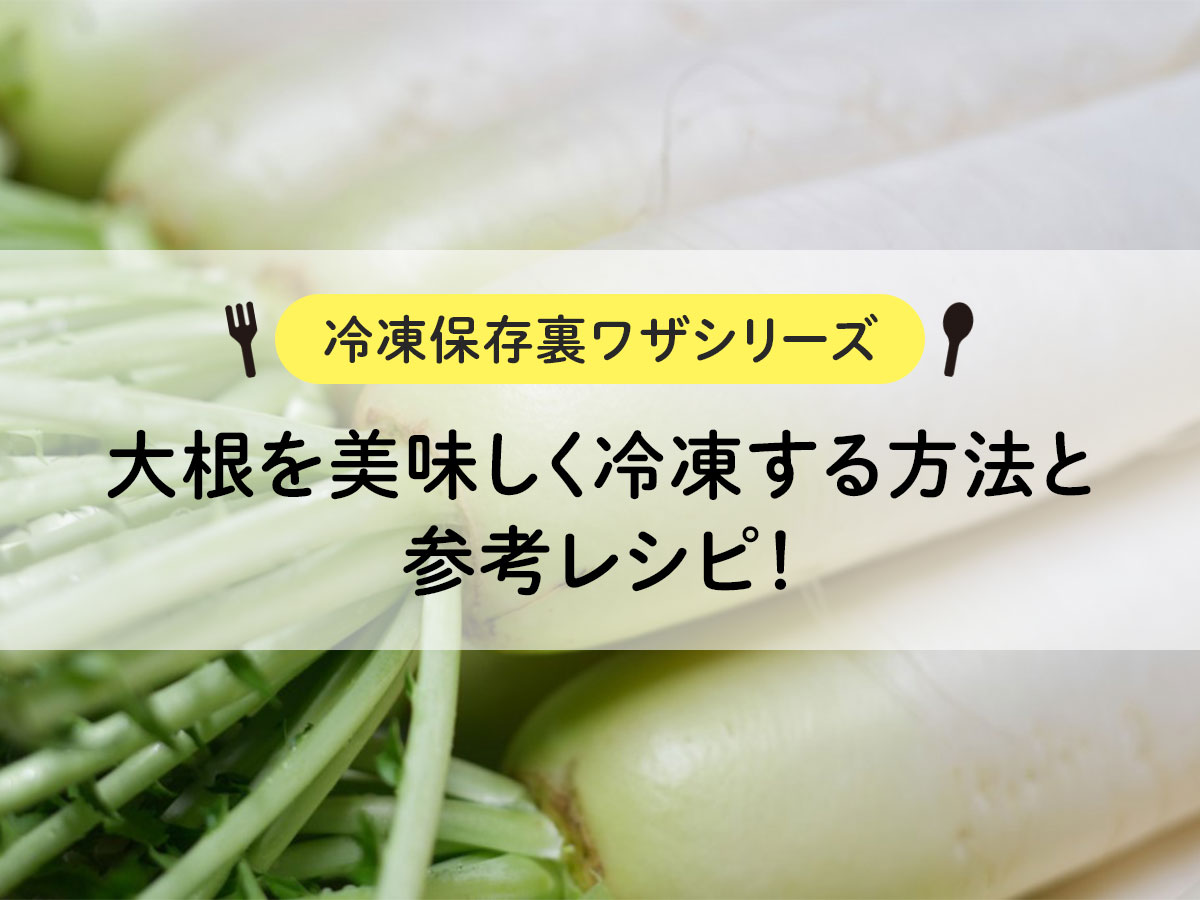
Have you ever bought a whole radish but couldn't use it all?
If you buy too many daikon radish or cannot use them all, we recommend freezing them. Freezing not only extends the shelf life, but also softens the food and makes it more flavorful.
It doesn't take much time to taste, so you can make delicious stews and oden in a short time.
Let's take a closer look at how to freeze daikon radish without losing quality, what to keep in mind, and the storage period.
We will also introduce delicious and easy recipes for stews, miso soup, and oden using frozen daikon radish.
目次
Anyone can do it easily! How to freeze radish
How to freeze radish
Take the leaves, wash them thoroughly with water, peel them, and cut them into convenient sizes.
If you want to use it as a stew, you can cut it into 2-3cm rounds or half moons, and if you want to use it as an ingredient in miso soup, you can cut it into ginkgo or julienne pieces.
There are two points to keep in mind when freezing food.
☑1、皮をむく際に厚めにむくこと
☑2、空気に触れないようにラップで密閉させること☑
The skin part has a lot of dietary fiber, and it becomes stringy when frozen, so it's better to peel it thickly so that it tastes better.
Also, if it comes into contact with air, it will dry out and oxidize, so it is important to avoid exposing it to air as much as possible. Wrap the cut radish tightly in plastic wrap, making sure to squeeze out the air.
You can further prevent quality deterioration by wrapping the product in plastic wrap and then placing it in a storage bag.
You can freeze it raw or par-boil it before freezing, but par-boiling it before freezing will prevent it from discoloring.
The most recommended is grated radish. It also retains its texture and flavor for a long time. Also, grated radish is very difficult to grate every time. Therefore, if you have any leftovers or time, it is highly recommended to grate them all at once and freeze them in small portions.
Grating breaks down the cells within the radish, making it less susceptible to damage from freezing. The quality of grated daikon radish does not change much even if it is frozen, so you can maintain the quality of the raw radish.
Freezing method with added effort
There is also a way to add seasoning and freeze it.
Cut the radish into 2cm pieces, place them in a storage bag, and add soy sauce, sugar, and mirin together. Make sure to cover it evenly with the seasoning and seal it.
By soaking the radish in seasonings and freezing it, the water inside the radish sticks to the molecules in the soy sauce and sugar, weakening the bonds between the water molecules and making it harder to freeze. Therefore, cell destruction can be prevented and quality deterioration can be suppressed.
This is the recommended preservation method when making boiled foods.
Storage period of frozen radish
Radishes can be stored for about a month by freezing.
If refrigerated, a whole bottle can be stored for 7 to 10 days, and cut pieces can be stored for about 4 to 5 days. If you keep it refrigerated for a long time, it will become stiff and lose its deliciousness.
It is also said that grated daikon radish tastes best when freshly grated, and the spiciness and umami characteristic of grated daikon radish disappears within a few minutes.
Therefore, if you cannot use the cut or grated daikon radish right away, it will be better to freeze it and eat it more deliciously.
>> 3 points to keep in mind when preserving vegetables
It tastes delicious! Advantages of freezing radish
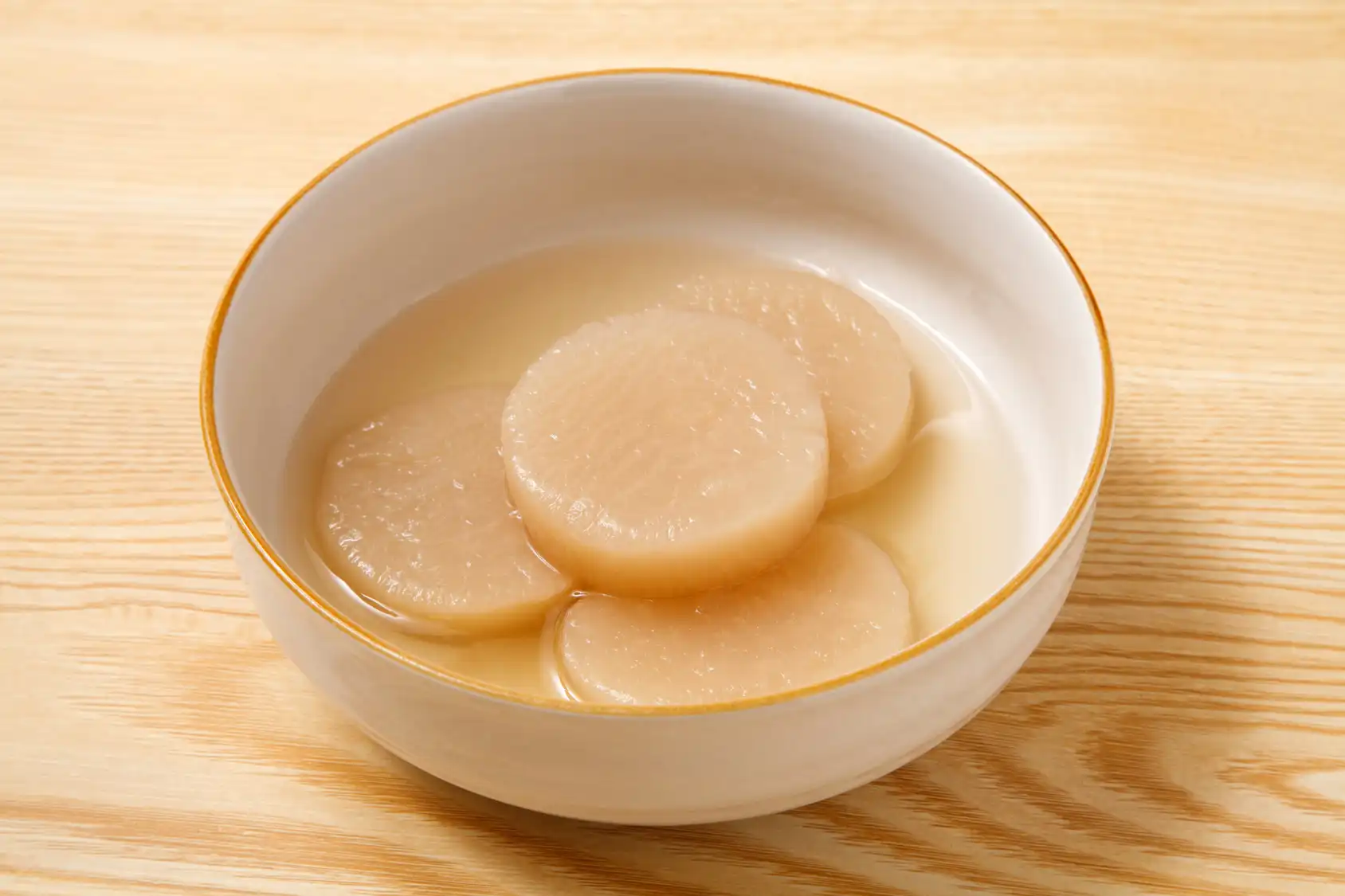
Savor the flavor and reduce cooking time
Freezing not only allows for long-term storage, but also has the advantage of softening the radish and making it easier to absorb the flavor.
When you freeze radish, the cells are destroyed, the moisture is removed, and the texture becomes bad. Therefore, unfortunately, it is not suitable for eating raw, such as in salads.
However, freezing destroys the cells, making it softer and more flavorful. By using frozen daikon radish when making stews and oden, you can make them in a short time.
rapid freezing does not reduce nutritional value
People tend to think that the nutritional value of food decreases when it is frozen, but by rapid freezing, it can be preserved without losing its nutritional value. When freezing at home, set the freezing mode to high so that the food can be rapid freezing as possible.
It is also important to limit the number of times you open and close the freezer, and close it immediately when you open it to prevent the temperature inside the freezer from rising. You can also use ice cube trays or metal trays to quickly lower the temperature.
Frozen daikon radish processed in a commercial rapid freezer is also available. Commercial rapid freezer have a much better freezing function than home-use freezers, so they can maintain the freshness and nutritional value of food before freezing.
Products processed into cut radish and grated radish are sold. It is easy to use and does not require any preparation, so it is convenient for those who use daikon radish frequently or during seasons when daikon radish prices increase.
A nutritionist explains! About the nutrition of radish
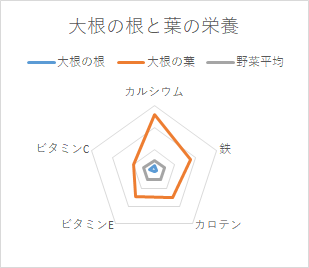
The root part of radish is a light-colored vegetable, and the leaf part is a green-yellow vegetable.
Keep your stomach healthy!
The root contains a large amount of a starch enzyme called amylase, which aids in digestion and is effective against heaviness in the stomach and heartburn.
Don't throw away the radish leaves!
The leaves contain a lot of vitamin C, and the roots contain a lot of beta-carotene. It is also rich in nutrients, including vitamin B1 B2, calcium, sodium, phosphorus, and iron.
Don't throw it away, use it by rubbing it with salt or stirring it into stir-fries.
☑根の部分の使い分け
根の部分を先端の下の部分、葉に近い上の部分、真ん中の中央部分に分けます。
下の部分⇒辛味が強く、繊維質が多いためお漬物やお味噌汁に
上の部分⇒甘味があるためサラダや大根おろしに
中央部分⇒水分をたっぷり含んでいて硬めのため、おでんなどの煮込みに
☆先端の方が辛く、上にいくほど甘くなります☝

Nutritionist Ruri
Obtained nutritionist qualifications from Toita Women's Junior College and graduated from the same university. After graduating from Kyorin University, he also obtained a qualification as a food hygiene manager. Currently at Daybreak Co., Ltd., he oversees various food freezing experiments while disseminating food freezing information. My hobbies are traveling and hula dancing.
For oden and stews! How to use frozen radish
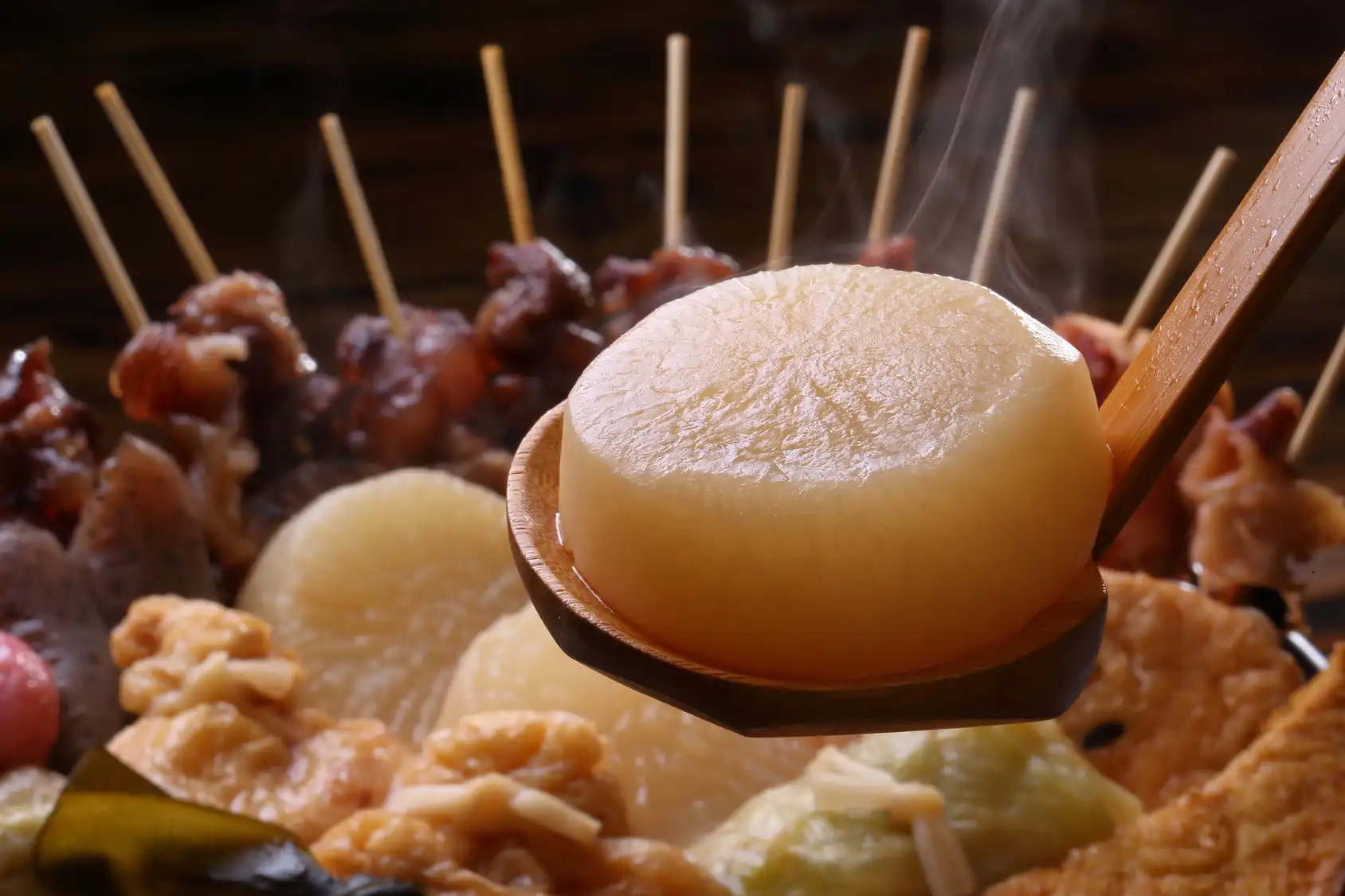
In order to use frozen daikon radish deliciously, we will introduce the best thawing method and recommended recipes. The recipe I will introduce this time is an easy recipe that can be made without the hassle of parboiling that is usually required.
How to thaw frozen radish
The best way to thaw frozen radish is to thaw it naturally. Grated radish can be easily used by simply taking out the amount you want to use from the freezer and letting it thaw naturally.
Also, frozen daikon radish is not suitable for salads, but it can be used in vinegar dishes.
If you want to use it for boiled dishes, etc., you can cook it in a frozen state, so there is no need to thaw it.
Recipe using frozen radish ① Boiled chicken wings
☑(材料)手羽元、大根、卵
Boil eggs to make boiled eggs. Make two slits in the chicken wings and sprinkle with salt and pepper. Place the chicken wings in a pot, add enough water to cover them, and bring to a boil.
Add the sugar, mirin, and dashi base, and when the chicken wings become soft, add the frozen daikon radish. When the frozen radish has melted, add the boiled egg and soy sauce and bring to a boil.
Adjust the taste, turn off the heat and let it cool. The flavor intensifies while it cools, so just before eating, warm it up again.
There is no need to parboil the radish, so you can make simmered dishes without spending much time or effort. It's delicious not only with chicken wings, but also with stews such as braised pork or yellowtail radish.
Recipe using frozen radish ② Miso soup
☑(材料)大根、油揚げなどお好みの具材
Pour the stock into a pot, bring to a boil, and add the chopped frozen daikon radish. When it boils again, dissolve the miso and add the thinly sliced fried tofu.
The radish becomes soft quickly, so it's useful on busy mornings.
Recipe ③ Oden using frozen radish
☑(材料)大根、こんにゃく、ジャガイモ、ゆで卵、お好きな練もの
(おでんのだし)昆布と鰹節でとっただし、塩、酒、みりん、醤油、オイスターソース
Peel the potatoes and make slits in the konnyaku in a grid pattern. Add the dashi stock made from kelp and bonito flakes, seasonings, and frozen daikon radish to a clay pot and simmer for about 30 minutes.
Add potatoes, konnyaku, and paste and simmer over low heat for another 30 to 40 minutes. Once the potatoes are cooked, add the hanpen and it's done.
When making oden, you have to parboil the daikon radish to make it soft and then boil it until the flavor infuses, which is time consuming and difficult. However, by using frozen daikon radish, you can make delicious oden in a short time.
Conclusion
If daikon radish is kept refrigerated for a long period of time, the moisture will be removed and the quality will deteriorate.
Therefore, if you can't use it right away, we recommend freezing it.
Frozen daikon radish is not suitable for eating raw, such as in salads, but it becomes softer and more flavorful, so it is perfect for making oden or stews.
You can easily make time-consuming dishes in a short time. Just peel the daikon radish, cut it into easy-to-use pieces, wrap it in plastic wrap, and freeze it, so give it a try.








![[Storage period increased by 30 times! ] Achieving a stable supply of raw whitebait!](https://shunkashutou.com/wp-content/uploads/2016/11/579c55e6d32e1385c250e8e7c3ed59a71.jpg)
![[Sales increased 100 times! ] rapid freezing the signature menu “Ni-katsu sandwich”!](https://shunkashutou.com/wp-content/uploads/2016/11/IMG_02391.jpg)
![[Horse sashimi] We have significantly reduced waste loss with rapid freezer!](https://shunkashutou.com/wp-content/uploads/2016/11/5fda59d0cbcdabde18e58c3c58c09ed0.jpg)




![[Storage period increased from 3 days to half a year! ] Restaurants are expanding their business using wholesale and mail order!](https://shunkashutou.com/wp-content/uploads/2018/04/66c19942ab4ba346fdb64ccc04cde373.png)
![[Reduce loss from 200 kg of oysters to zero] Improve loss and expand business with rapid freezer](https://shunkashutou.com/wp-content/uploads/2018/06/19785ca583a8d3c4041c7c192d041b0d.jpg)












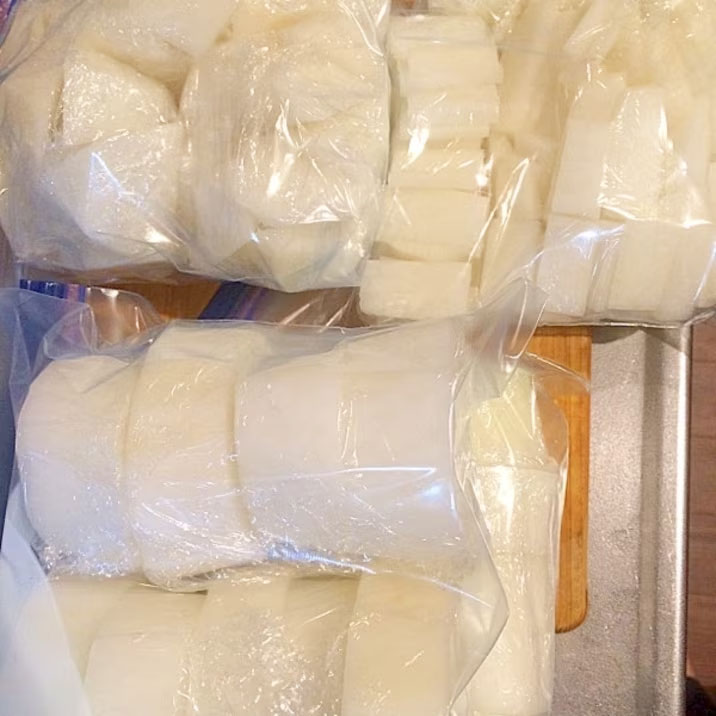


![[Explanation with photos! ] Introducing the method and recipe for freezing komatsuna](https://shunkashutou.com/wp-content/uploads/2023/09/5d2a19a6e6cfb5ad0329d8fce162f292.jpg)
![Introducing the method and recipe for freezing eringi mushrooms [Explanation with photos! ]](https://shunkashutou.com/wp-content/uploads/2023/08/a360f0e10b69512c896510215ae51a7f.jpg)
![[Easy and delicious] How to make and thaw frozen eggs, applied recipes](https://shunkashutou.com/wp-content/uploads/2023/08/6b20ec40a9845d4a62952c143f83456f.jpg)
![[Can it be frozen?] Stew freezing method, storage period, and arrangement recipe](https://shunkashutou.com/wp-content/uploads/2023/10/f599b814ea21eef57604e4ceb2518d5b-1.jpg)
![How to freeze chicken, storage period, and 5 recipes! [Explanation with photos! ]](https://shunkashutou.com/wp-content/uploads/2023/08/01f6582931e13522ee0d1ee900be2d1d.jpg)
![[Lunch boxes are easy! ] Techniques and recipes for effectively using frozen side dishes](https://shunkashutou.com/wp-content/uploads/2023/07/reitou-bento-1024x682-1.jpg)
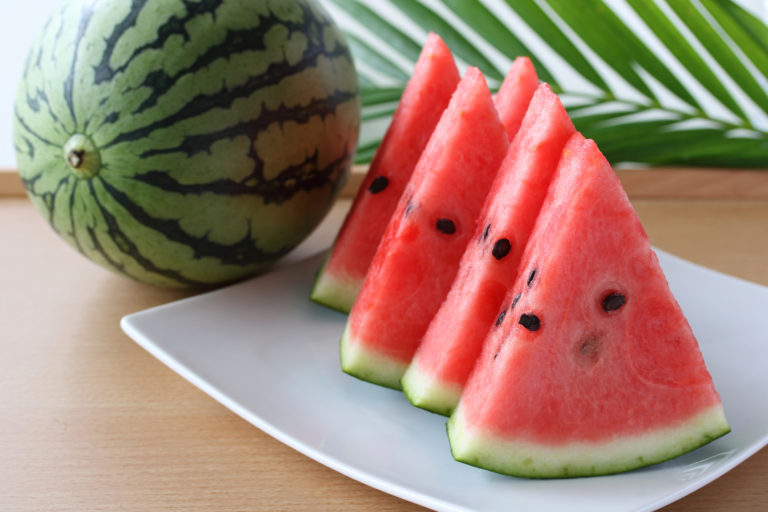
![How to freeze zucchini and 5 recipes! [Explanation with photos! ]](https://shunkashutou.com/wp-content/uploads/2023/10/zucchini6-768x512-1.jpg)
![[Can it be frozen? ] How to freeze konjac and diet recipes](https://shunkashutou.com/wp-content/uploads/2023/09/ec03b3e5cdefedf8f295de7ebb781752.jpg)
![[Can it be frozen? ] Introducing how to freeze kamaboko and how to remake it](https://shunkashutou.com/wp-content/uploads/2023/09/6d2830823df2896a1601685353b0fdf5.jpg)
![Introducing how to freeze and thaw whitebait, as well as recipes for its use [Full of nutrition! ]](https://shunkashutou.com/wp-content/uploads/2023/10/04d15012ec36f91a5574f63dfa9d4771.jpg)
![How to freeze tomatoes, storage period, and 5 recipes! [Explanation with photos! ]](https://shunkashutou.com/wp-content/uploads/2023/10/tomato-768x513-1.jpg)
![How to freeze and thaw chestnuts, storage period, and 5 recipes! [Explanation with photos]](https://shunkashutou.com/wp-content/uploads/2023/09/c590a9e6fb16ed45fe2fdd32813de03b.jpg)
![[Explanation with photos! ] A good way to freeze lotus roots and recipes to use them!](https://shunkashutou.com/wp-content/uploads/2023/10/adac4ea3f269121c4cb5e74b323508f5.jpg)
![[Can it be frozen? ] How to freeze fresh cream, storage period, thawing method and 5 recipes!](https://shunkashutou.com/wp-content/uploads/2023/09/1887f5bd8f2d7f9ef1d88754f2c5bcc4.jpg)
![Introducing how to freeze carrots and recipes [Explanation with photos! ]](https://shunkashutou.com/wp-content/uploads/2023/08/837a12b0247130309b466717f2b8c53c.jpg)
![[Can it be frozen? ] Mentaiko frozen storage, expiration date, and carefully selected recipes!](https://shunkashutou.com/wp-content/uploads/2023/09/618266af112a78579edd3bff41c2a804.jpg)

![How to freeze parsley, nutrition, and 5 easy recipes! [Solved with photos! ]](https://shunkashutou.com/wp-content/uploads/2023/09/paseri-768x513-1.jpg)
![[It's good to know! ] Introducing how to freeze curry, how long to keep it frozen, and how to thaw it |](https://shunkashutou.com/wp-content/uploads/2023/08/5de5495c896622dc896a8f23d9528300.jpg)
![[Can it be frozen? ] How to freeze dried daikon radish and arrange recipes!](https://shunkashutou.com/wp-content/uploads/2023/09/84f89f802d6869949972432e7b3be19c.jpg)
![[Can it be frozen? ] How to freeze cabbage rolls, storage period, and recipe](https://shunkashutou.com/wp-content/uploads/2023/10/f5c1db9a17ef7843ffd45f5ccb160ed5.jpg)
![Introducing recipes and methods for freezing and thawing bananas [Explanation with photos! ]](https://shunkashutou.com/wp-content/uploads/2023/07/494e7567627fb35e47ee5cb0e06e142c.jpg)
![How to freeze apples and what is their nutritional value? Perfect for baby food! [Explanation with photos! ]](https://shunkashutou.com/wp-content/uploads/2023/10/cf0380a4b371d2f43e0f0ed99c7344a2.jpg)
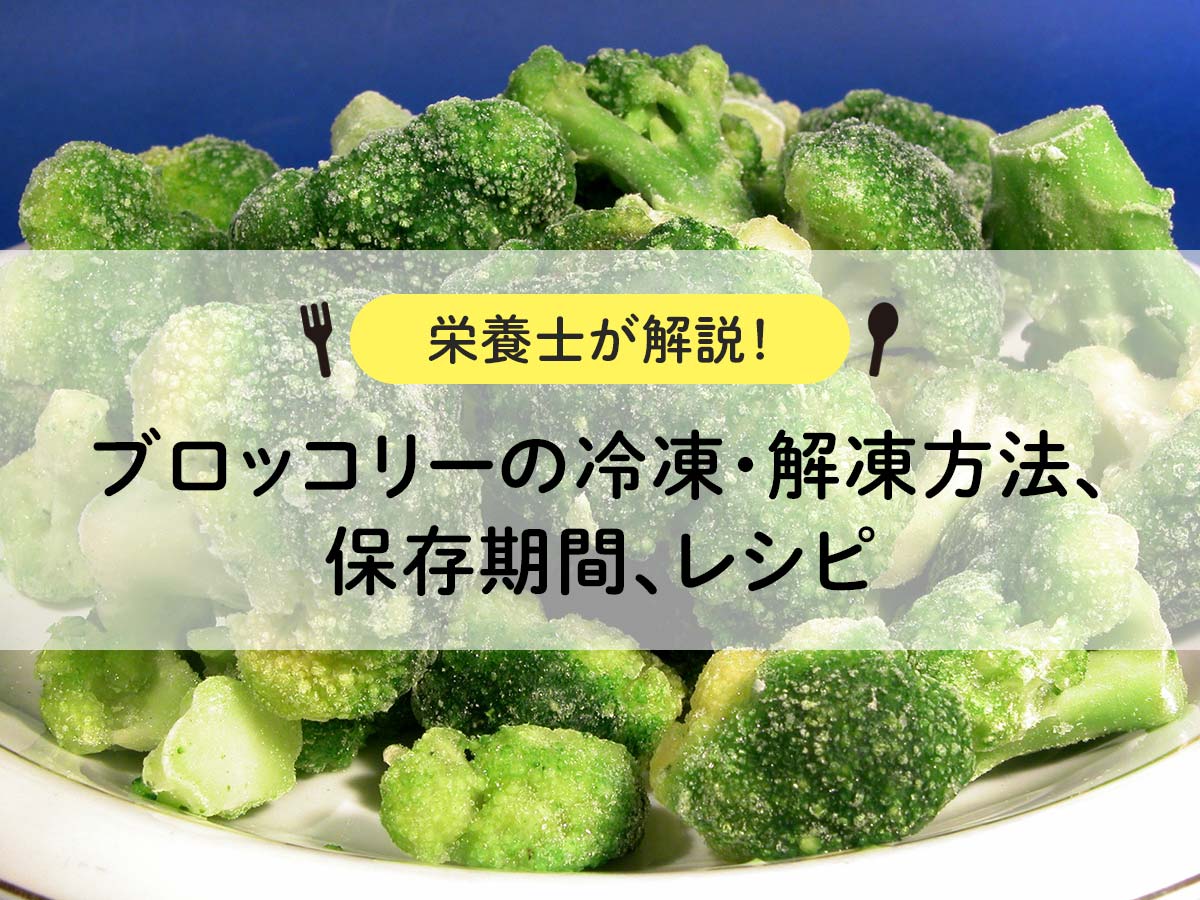
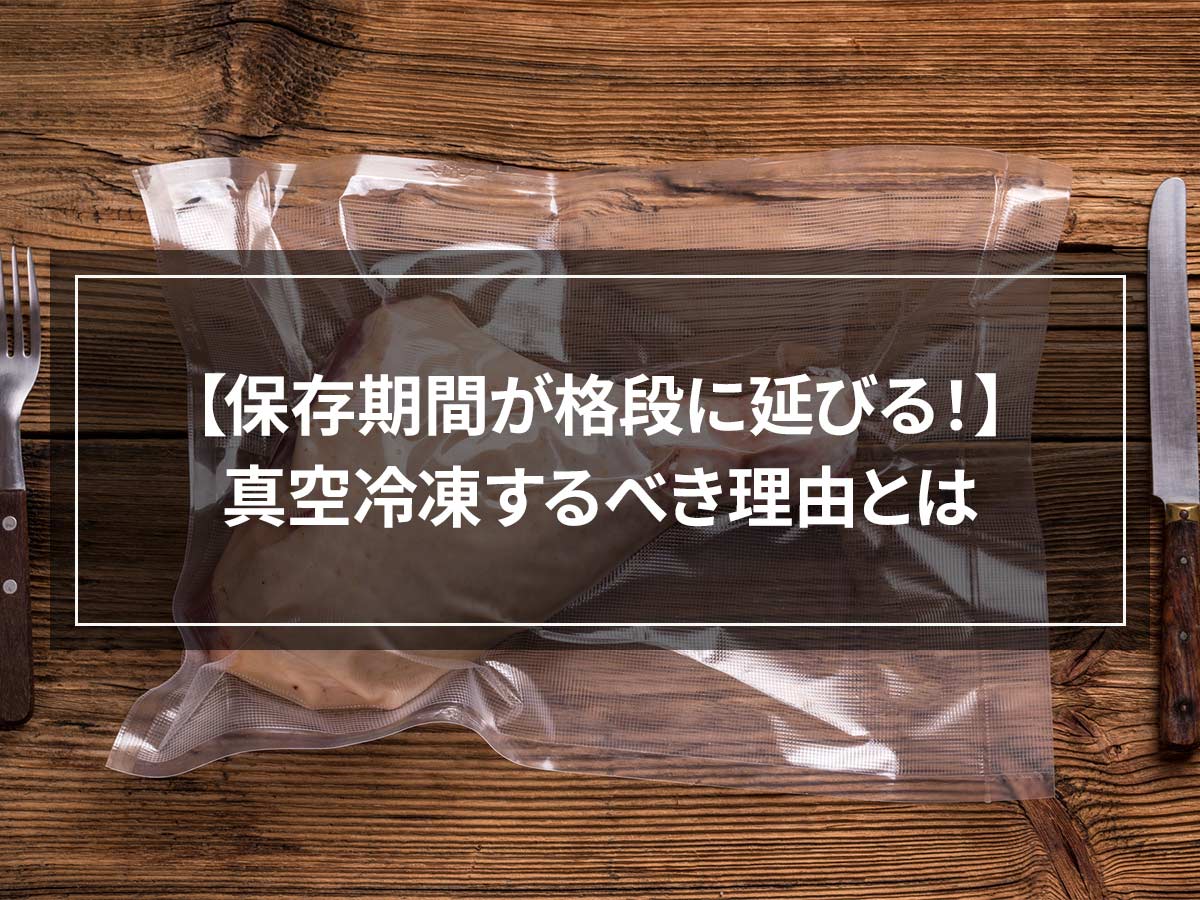
![How to freeze mizuna and 5 recipes! [Explanation with photos! ]](https://shunkashutou.com/wp-content/uploads/2023/09/b22c59559b7316b40d35d2555434791e.jpg)
![[Dramatically extends the shelf life of vegetables! ] What is blanching process?](https://shunkashutou.com/wp-content/uploads/2023/07/8fce721a563a0e86a740b4d11dc63766.jpg)
![How to freeze/thaw turnips, storage period, and 5 recipes [Explanation with photos]](https://shunkashutou.com/wp-content/uploads/2023/09/eae0789d04cc4971cf4232963b4d2231-1.jpg)
![[Nutrition remains the same! ? ] Introducing how to use frozen vegetables and recommended recipes](https://shunkashutou.com/wp-content/uploads/2023/10/vegetables-reito-1-1-768x511-1.jpg)
![[Osechi remake dishes too! ] Introducing the method and recipe for freezing black beans](https://shunkashutou.com/wp-content/uploads/2023/09/9bcd5b0667eef32b7c7daf786e01172f.jpg)
![[Explanation with photos! ] How to freeze beef, storage period, and 5 recipes!](https://shunkashutou.com/wp-content/uploads/2023/07/8717f2a867f52157bab47841b0f29019.jpg)
![Introducing how to freeze ginger and recipes [Explanation with photos]](https://shunkashutou.com/wp-content/uploads/2023/09/myoga4-624x432-1.jpg)
![[Includes grilling instructions] How to freeze hamburger steak, storage period, and carefully selected recipes!](https://shunkashutou.com/wp-content/uploads/2023/09/eb3a531f7fd023f973240f698c092b64.jpg)

![[Explanation with photos! ] How to freeze and fry croquettes, 5 carefully selected recipes](https://shunkashutou.com/wp-content/uploads/2023/09/b364ee97a71777f9dd2e35fddbbdda72.jpg)
![[Need to know] 7 points to thaw frozen crab deliciously](https://shunkashutou.com/wp-content/uploads/2023/08/394440560c05fb5b512d75b81a3fae4f.jpg)
![How to freeze celery, nutrition, and 5 recipes! [Explanation with photos! ]](https://shunkashutou.com/wp-content/uploads/2023/09/serori-768x512-1.jpg)
![[Explanation with photos] How to freeze salmon fillets, storage period, and 5 recipes](https://shunkashutou.com/wp-content/uploads/2023/10/fb96564ba06a8cc88a72f0c971ad54e5.jpg)
![[Explanation of how to boil shrimp] How to freeze shrimp, storage period, and 5 popular recipes!](https://shunkashutou.com/wp-content/uploads/2023/08/4667337fff2317bbcbfc844944c7834b.jpg)
![[Can it be frozen? ] Introducing a good way to freeze green peppers and side dish recipes](https://shunkashutou.com/wp-content/uploads/2023/09/30407f106c5c082468c66af0d40c5858.jpg)
![[Should be frozen! ? ] How to freeze and thaw bread, 5 carefully selected recipes!](https://shunkashutou.com/wp-content/uploads/2023/10/4691acc32cab80284fa0cddf72d58e95.jpg)
![[Explanation with photos! ] How to freeze taro, storage period, and 5 recipes!](https://shunkashutou.com/wp-content/uploads/2023/10/116858380_-768x512-1.jpg)
![Explaining how to freeze tempura with photos! [Storage period, thawing, carefully selected recipes]](https://shunkashutou.com/wp-content/uploads/2023/10/51f33cde78d02d01a9e827132e4f069d.jpg)
![[Explanation with photos] Freezing and storage period of yellowtail fillets, carefully selected recipes!](https://shunkashutou.com/wp-content/uploads/2023/08/2613b1c938d382e3afc17125432167f0-1.jpg)
![How to freeze natto, expiration date, baby food and carefully selected recipes [Explanation with photos! ]](https://shunkashutou.com/wp-content/uploads/2023/07/055e5e865986b68d11c3f49f11ea6008.jpg)
![[Tips for making egg rolls that can be frozen] Introducing freezing methods, storage periods, and recipes!](https://shunkashutou.com/wp-content/uploads/2023/10/tamagoyaki-768x512-1.jpg)
![[Explanation with photos! ] How to freeze green beans, storage period, and 5 recipes](https://shunkashutou.com/wp-content/uploads/2023/09/f3dbbe5b1d05a50f514a833efdceced9.jpg)
![How to freeze delicious strawberries and 5 recipes! [Explanation with photos! ]](https://shunkashutou.com/wp-content/uploads/2023/09/1509eaf30e7a2fc1b5bbc88ae15a4034-1.jpg)
![[Freezing pickles] rapid freezing demo](https://shunkashutou.com/wp-content/uploads/2016/09/54443af8b86c85071ce9c09d80430b9a.webp)
![Explaining how to freeze Maitake mushrooms, their nutritional value, and recipes! [Explanation with photos! ]](https://shunkashutou.com/wp-content/uploads/2023/09/9face03809f7fcaf2e3599773b2e8c80.jpg)



